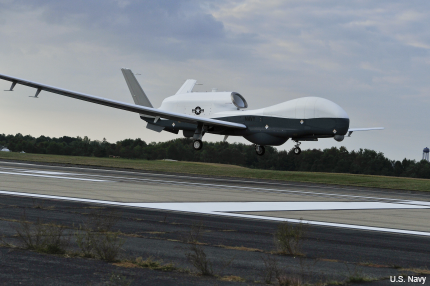Navy's Triton UAV takes its first cross-country flight
The unmanned maritime surveillance aircraft has flown from California to Maryland for the start of operational testing.

The Triton arrives at Naval Air Station Patuxent River, Md.
The Navy’s MQ-4C Triton successfully conducted its first cross-country flight last week, as the program moves from initial flight testing to operational testing.
The unmanned aircraft system’s ferry flight began from a Northrop Grumman facility in Palmdale, Calif., and ended when it landed at Naval Air Station Patuxent River, Md. The flight plan for the 11 hour, 3,290 mile trip plotted a route along the southern U.S. border, the Gulf of Mexico and Florida.
In order to avoid conflicts with civilian aircraft, the Triton flew at heights more than 50,000 feet. Commercial jets typically fly at a cruising altitude around 39,000 feet.
Once at Pax River, the Triton will undergo integration and tests of its sensor and communications systems. A second Navy MQ-4C will arrive at Pax River in the next several weeks. Northrop Grumman, the primary contractor for the MQ-4C, will also send its demonstration test article to the naval air station.
The cross country flight required prior testing supported by the Air Force and tracking systems provided by NASA.
"The coordination to bring the Navy's largest unmanned asset across the country was significant and involved many organizations," Capt. Jim Hoke, Persistent Maritime Unmanned Aircraft Systems (PMA-262) program manager, said in a Navy release. "This phenomenal team executed the system's longest flight to date exactly as planned."
The Triton will use a multi-sensor payload to conduct intelligence, surveillance and reconnaissance missions in conjunction with manned P-8 Poseidon maritime patrol aircraft. It will be equipped with the Multi-Function Active Sensor (MFAS), a scanned array radar with a 360 degree field of view. Sensor data gathered by the Triton would be disseminated to units supporting the Navy’s Expeditionary Strike Group, Carrier Strike Group and the Joint Forces Maritime Component Commander.
Based on the RQ-4 Global Hawk, the Triton will have thicker wings and anti-ice systems on the leading edges of its wings and engine inlet to allow it to ascend and descend more quickly, according to the Air Force. At 130.9 feet, the unmanned aircraft has a wingspan wider than a Boeing 737’s.
The Triton will have an endurance of up to 24 hours and be able to maintain a view radius of over 2,000 nautical miles, allowing it to cover more than one million square nautical miles in a single mission.
The MQ-4C Triton completed initial flight testing in March 2014, and had 15 flights prior to the ferry flight. The three test vehicles currently in use will fly about 2,000 hours before achieving initial operational capability in 2017.

